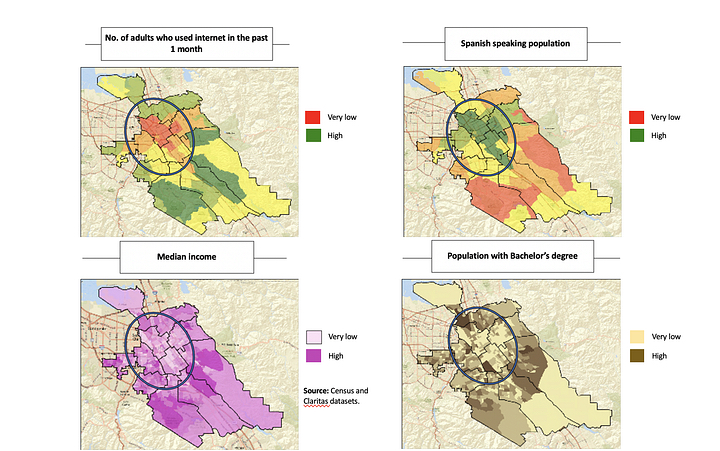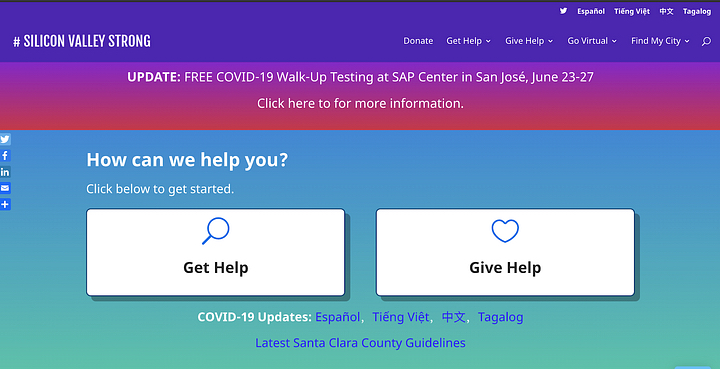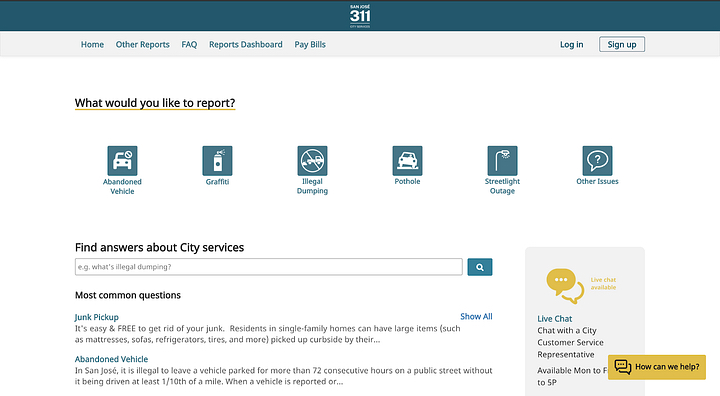San José, California, USA
Project Type:
Community Engagement, Cross-Sector, Equity, Health & Wellness, High-Performing Government, Infrastructure, Technology
2023 Gold Certification
San José is maximizing AI opportunities and minimizing risk with its new AI practices and framework. When San José originally achieved Certification in 2020, the City was closing the digital divide and building out a citywide digital infrastructure. Today, they’re still technology pioneers with their new AI Review Framework. The framework lays out the process for departments to request AI tools and assess benefits and risks when considering these AI tools. San José also launched a public Algorithm Register to share the purpose and impact of the City’s current AI systems. Additionally San José joined an AI coalition with 100 U.S. government agencies to best navigate the benefits and risks of AI. San José’s AI approach is an example of how to reap the rewards of AI, mitigate risk, and boost trust and transparency with residents.
“Since taking office last year, we’ve strived to make City Hall more data-driven and accountable for results through the implementation of dashboards across many departments. San José is officially one of the most data-driven, well-managed local governments across the country and we’re working tirelessly to create the safe, clean, housed city we all deserve.”
2020 Silver Certification
Implemented public-private partnerships to identify barriers to break down the digital divide and make internet access more equitable in one of the nation’s largest cross-sector digital inclusion efforts to date.
Set up grant-based contracts for local community-based organizations to help them deliver broadband to 50,000 unconnected households by the year 2030.
Launched an app for residents to both submit service requests and receive service information from the city, which fields 165,000 service requests a year.
The Silicon Valley
San José ’s status as the capital of booming Silicon Valley is hard to miss. Construction cranes dot the skyline, powering the City’s steady downtown growth. Major tech companies like Zoom and Cisco call the city home, Google will soon open a huge new campus on 60 acres downtown, and giants like Apple and Facebook are headquartered in suburbs just to the west. With great pride in its diverse heritage, this is a city oriented toward the future, a stance reflected in San José City Hall. The postmodern structure’s glass-paneled rotunda confidently embraces the Valley’s nearly constant sunshine.
With five major roadways criss-crossing the city, a gleaming new BART line, and a major public transportation hub set to open in 2021, strengthening connections to Oakland and other East Bay locales, San José is poised to become a true hub of the Bay Area. The region’s tech talent and entrepreneurial spirit is alive in City Hall, with leaders and staff of all stripes having spent time in the local private sector. They bring big aspirations of impact to this diverse city of more than one million people, of whom 40 percent were born outside of the United States, and over 10 percent live under the federal poverty line.
Underlying San José’s aspirations is a foundational belief in balancing innovation with equity and inclusion. It’s a new take on the Silicon Valley-esque mindset of growth at all costs. And it’s at the core of its “Smart City Vision” to deploy data-driven decision making and technology to continuously improve how City Hall serves residents.
Using Data to Bridge the Digital Divide
Universal broadband access is part of the city’s current “Smart City Roadmap.” The fact that people in Silicon Valley’s largest city lack broadband access was unacceptable to city leaders, so in 2016, working from the premise that internet access is a basic human right in the 21st century, former Mayor Liccardo launched the Digital Inclusion Fund, pledging to close the digital divide.
Led by the Mayor’s Office of Technology and Innovation and the City’s Office of Civic Innovation and Digital Strategy, this public-private partnership between local government teams and external partners is believed to be the nation’s largest cross-sector digital inclusion effort to date.
The first step was to learn who lacked access. Working with external partners such as Stanford University, the City’s digital inclusion team used a variety of data sources to identify over 95,000 San José households without access to broadband. After creating a heat map of the digital divide down to the neighborhood level, the team canvassed over 600 residents and conducted street surveys and interviews in multiple languages to identify primary barriers to access.

“We knew we needed to bring ‘hyper local’ solutions to San José’s digitally underserved communities. We integrated several data sets to develop a geography-based ‘Digital Exclusion HeatMap’ that allows the City and our partners to know exactly where to expand existing programs and develop new solutions — which library, community center, or park, for example, would be most effective in providing free Wi-Fi, device lending, and digital literacy training to our underserved communities in East San José.”
With this essential data in hand, the team identified three critical components for digital inclusion: (1) an affordable broadband connection at home, (2) a working device, and (3) digital literacy skills. The City then made the case to external private-sector funders, including major telecom companies and others in the private sector, to help fund the initiative.

Funding for San José’s broadband strategy is bolstered by the deployment of “small cell” technology — basically, 5G-compatible antennae that can be installed on rooftops, streetlights, and other locations. Beckel’s team negotiated innovative outcomes-driven contracts with telecom companies Verizon, AT&T, and Mobilitie on behalf of Sprint: pricing was structured so that the cost per broadband-enabling small cell site built by the telecom giant was tied to the number of sites built. To support residents in need of the other two components of true digital inclusion — working devices and digital literacy — the team set up grant-based contracts with the California Emerging Technology Fund (CETF) and local community-based organizations.
The City is now on its way to improving broadband for all San José residents while simultaneously delivering broadband to 50,000 unconnected households by the year 2030. Since the implementation of the digital inclusion program began, 23 grants totaling $1,000,000 have been issued to San José community-based organizations with the goal of achieving 4,000 “adoptions” in the next year (i.e., connecting previously unconnected households to broadband internet access, ensuring household members have the appropriate devices, and providing digital literacy training). Average connectivity speeds across the city have improved fivefold to 30Mbps per second, and permits approved for construction of small cell sites have skyrocketed — up from five permits total in 2017 to more than 70 permits each week as of early 2020.
The vital importance of closing the digital divide and building out a city-wide digital infrastructure that connects all its residents — and ensures equity in digital access — was underscored by the COVID-19 pandemic. San José was one of the first places in the country under a stay-at-home order, which immediately presented challenges for work and education for the thousands of school-aged children in the city.

In addition to its ongoing digital divide work, to respond to the immediate needs at hand, the City quickly partnered with on-demand tech companies like DoorDash to support meal delivery to vulnerable residents. San José also steered critical regional leadership by launching Silicon Valley Strong, a multi-city initiative where residents can give help or get help with COVID-19 related issues. To date, more than 3,000 volunteers have signed up through the online platform, millions of free meals have been distributed throughout the metro area, more than 200 internet-enabled devices have been collected and distributed, and $27 million in donations have been raised.
Fighting Blight While Boosting Resident Engagement: There’s an App for That
San José’s city government has also improved its own digital infrastructure in recent years. In 2019, it launched My San José, a dashboard residents can access either through a mobile app or web browser to both submit service requests and receive service information from the city. Since My San José’s launch, the City has fielded 165,000 service requests a year.
The vision behind this tool, now called San José 311, is to “use data to make it easier for the community and local government to work together to keep San José safe, clean, and engaged,” according to Deputy City Manager Kip Harkness.

To that end, the dashboard focuses on five types of service requests: abandoned vehicles, graffiti, illegal dumping, potholes, and streetlight outages. Before, if residents wanted to request services related to these things, they would have to find the right phone number to reach the right call center, and rely on the call center to email the request to the right departments.
Now, residents submit their request through San Jose 311 and automatically receive information about expected turnaround time and the status of their request. Great customer service is built into the platform where residents receive confirmation that an issue has been resolved and an opportunity to provide feedback to the city. The City can now collect and analyze a robust set of data on specific service request areas and neighborhood needs, and strategically deploy staff and resources to boost efficiency and productivity. Real results have come from the new far more user-friendly system, including:
— Abandoned vehicles. The average initial response time for inoperable vehicle removal dropped from 15 days to four days over the last 12 months. Average time to complete a service request dropped to about nine days, from 27 days. A giant backlog of over 4,000 service requests was prioritized so that important requests were not left waiting, and has now been whittled down so that few high-priority requests remain untackled.
— Illegal dumping. Response times to cleanup requests used to take up to six months — they’ve dropped to less than a week thanks to work done over the past two years. With service requests far easier to make (they’d been handled over the phone historically), they have doubled within a year of the dashboard’s launch. The City staffed up, using service request data to justify an increased number of workers.
These kinds of improvements deliver tangible benefits to residents. Various studies have shown a high degree of correlation between neighborhood cleanliness and crime. The City is determined to use data-driven tools to remove early signs of blight — thereby preventing the need for more police services down the road. And there’s another benefit: Residents involved in service requests report being more engaged with the city, Harkness says.
“Responsiveness matters to those feelings of being heard and being engaged.”
Further progress is on the way, including language translation in Spanish and Vietnamese to increase community engagement, and piloting a chatbot to help reduce calls into the call center. Additionally, the City plans to add new services to the platform, starting with automating manual processes for recycling. The city is only “scratching the surface on the data we’re getting from San Jose 311,” Harkness adds.
Charting a ‘Smarter, Leaner’ Future
San José’s data-driven, iterative approach to innovation — which embraces “failing fast” to drive continuous improvement — is familiar to anyone who has spent time around tech startups. But the City’s mindset isn’t just a reflection of its Valley surroundings. It’s taken root out of necessity.
Through a long, slow recovery from the Great Recession of 2008, the City has had to use data to drive efficiency. Budget cuts reduced the city’s workforce by 16 percent from its pre-recession peak. Compared to similar-sized cities, San José has an extraordinarily lean staff: 6,700 employees for just over one million residents.
“We’re the leanest big city in the country,” former City Manager Dave Sykes says. “We cannot just throw resources at a problem to solve it. We need to be making decisions that are informed. We have to be smarter, leaner about how we do our work.”
“We have the capacity to use Silicon Valley’s genius to make this a valley of opportunity — that’s really important to us,” Beckel says. “We have a core of people who push hard to find different ways to do things better. This is a city and team laser-focused on addressing what matters to people in this city.”
“We are starting to measure what it is that the community wants and support the priorities of elected officials with data. The open data portal is the perfect place around which to coalesce those conversations.” says Chief Data Officer Joseph D’Angelo

And, once an initiative gets underway, city officials look for evidence of success quickly. If something “fails fast,” that’s OK — it informs how the city uses resources going forward.